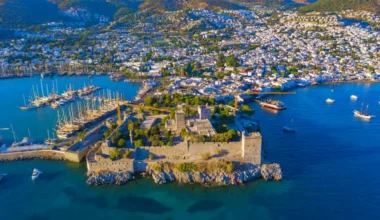Top Attractions Mugla
In this blog, we will give informations and links of the pages about Top Attractions In Mugla. You can reach every detail about these Attractions of Mugla via internal links and outbounds like Google maps links. While you are reading, you will feel as if you were there! Marmaris waterpark
Between the Aegean and Mediterranean Seas, Mugla is the place where you don’t age and has a lot of must places to visit. The history and nature are protected by law. However, sea and pine forests are mixed like an aquarium.
Muğla is located in the south of the Aegean Region and Muğla invade visitors’ mind with historical and cultural values. They are preserved from past to modern time, and its sun, deep blue sea and preserved bays. We recommend you to visit there during summer.
Muğla has always been home to many civilizations throughout history. The first human settlement in Muğla traces back to the pre-historic period according to the rock paintings during your walking. Since the ancient times, Mugla has always been a center of lots of cultures.
Visitors to Muğla enjoy the sea and sand and sun during their stay. Furthermore, They visit hundreds of museums and archaeological sites in the region. They also have a journey through history.
Muğla Culture House
Muğla Culture House (Muğla Kültür Evi) is among the most loved and visited places. They can see Turkish and Greek architecture together in the House of culture dating back to the 1800s, nationalized in 1999.
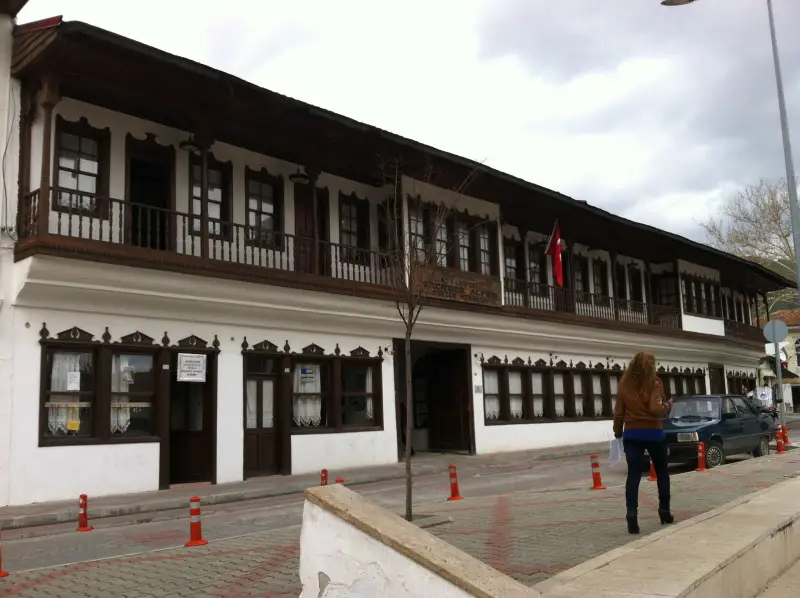
Mugla Museum
Mugla museum is among the top attractions in Mugla. She has a two-storey rectangular plan with an open garden and Archeology, Ethnography, Gladiators and Natural History Halls. In the Ethnography section, accessories of everyday clothing, utensils, whole outfit related to the weaving and carpentry profession. The Gladiators hall has 7 Gladiator grave steles. They were received from the Stratonikeia ancient city. Animal and plant fossils of 9 million years are exhibited in the archaeology section.
If you are into history, You should read our blogs about Gobekli Tepe, Karahan Tepe and Boncuklu Tarla!
Yağcılar Inn
The Yağcılar Inn’s (Yağcılar Hanı) history traces back to the 1940s. It was an important trade centre in the past. There is a resting area under the shade of the plane tree in the garden of it. It is consisted of former oil production facilities, called the yağhane. We advice your taking break under this plane tree during your trip. This place is is among the top attractions in Mugla.
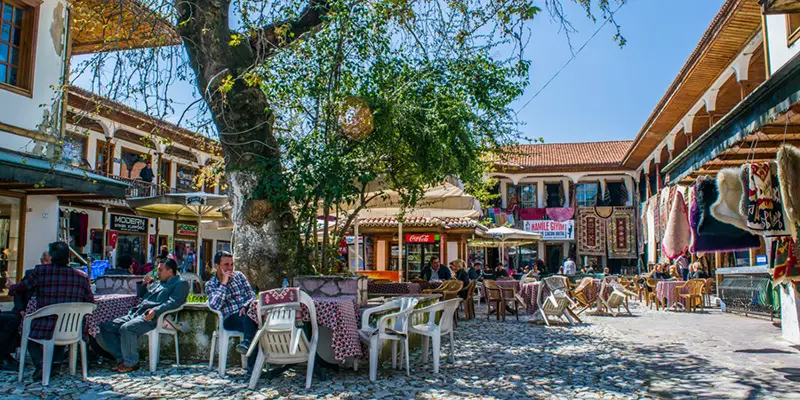
Saburhane Square
Saburhane Square (Saburhane Meydanı) is a typical settlement. In this area, the architecture is shaped in harmony with the geography, where different cultures, Turkish-Greek / Muslim-Christian, live together. The square is named after the prison that used to be located here. Saburhane Square is a typical Urban Site with nearly 400 registered houses. Furthermore, It also includes 170 examples of civil architecture, 100 streets, old inns, fountains, bazaars, squares and mosques. Some houses can be reached through courtyard gates in the dead end streets. Porches and Patios, wooden decorations, verandas, closet-shaped bathrooms embedded in the wall are the distinctive features of Muğla houses. These are among the top attractions in Mugla
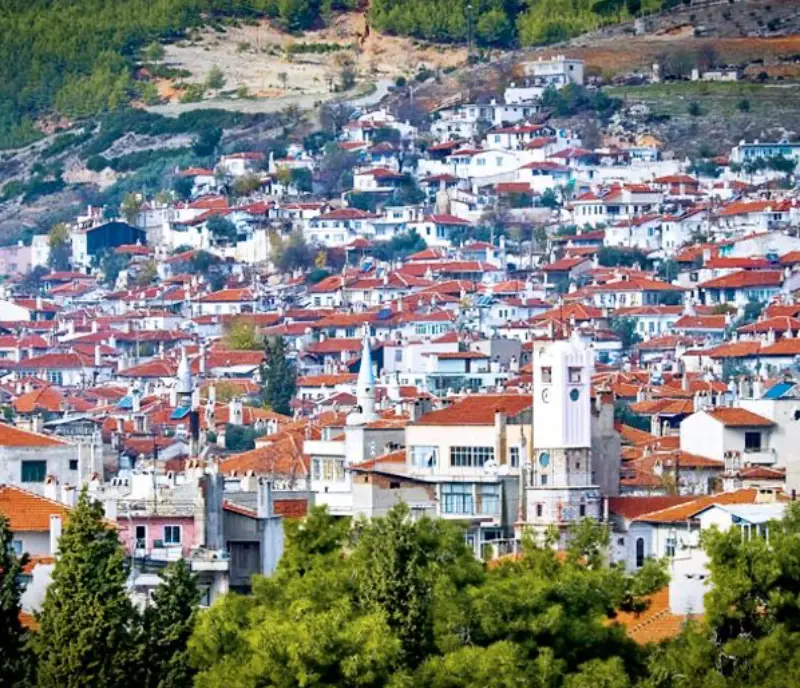
Muğla Houses and Their Unique Chimneys
One of the important symbols of the city, Traditional Muğla Houses are famous for being in harmony with their environment. It is possible to divide Muğla houses into two as Turkish houses and Greek houses. Nevertheless, The distinction between haremlik and selamlık (separate places for women and men) in traditional Turkish houses isn’t included in Muğla houses. The area opening to the garden in Turkish houses generally built on two floors is called “Hayat (life)“.
Greek houses, on the other hand, are usually two-storey stone-built houses with simple designs. The ground floor is generally planned as a warehouse for goods and animals and the other as a living space. That the houses facing the street or the road are not separated by a wall shows the social status of the trader. These houses are among the top attractions in Mugla.
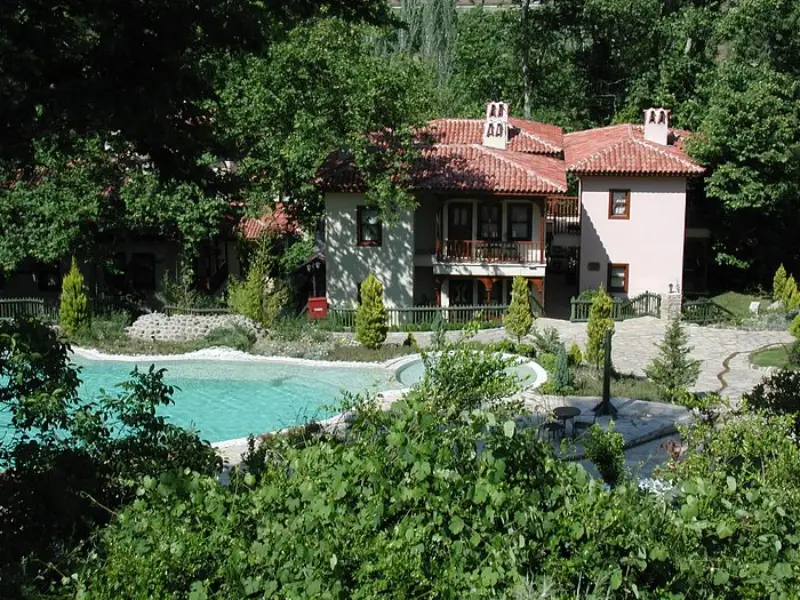
The most important feature that differentiate Mugla houses from other houses in the region is their chimneys. Climate plays an important role in shaping Muğla chimneys. Chimneys are shaped in a rectangular shape by covering the top in order to hinder the wind and rain. The “Muğla Chimney” formed by Turkish style tiles in the hands of stone masters has become the landmark of the city. This place is among the top attractions in Mugla.
Historical Arasta Bazaar
Since the only route connecting the city to the outside world was the İzmir, Aydın – Cine, Tavas – Denizli route, the caravans having to use this route were passing through Mugla. Camel caravans would entered the city from today’s Sekibaşı Street. They followed this road. They would reach the centre and stay in Yağcılar and Kocahan Inn, the commercial centre of the Urban Protected Area today.
Having left the city from the Saburhane district, they reached Tavas on the “Yılanlı Mountain Road (Yılanlı Dağ Yolu)“, still present today. From there, they passed to Denizli. You should know that Inns such as The Yağcılar Inn (Yağcılar Hanı), İbrahim Inn (İbrahim Hanı), Bacılar Inn (Bacılar Hanı), Balcıoğlu Inn (Balcıoğlu Hanı), Konakaltı Inn (Konakaltı Hanı), and the Kocahan, which doesn’t exist anymore, were the most active places of the city in the past. They were located on the route the historical caravan route passes through. There were guilds of various professions in the Arasta Bazaar (Çarşısı) which is among the top attractions in Mugla. They gave their names to the places they took place all together.

Currently,“Demirciler Arastası” and “Bakırcılar Arastası” are still called the same. Tabakhane, located in the north of the Arasta, was an important commerce centre in the city. The leathers processed here attracted attention of the caravans. Other goods important to the caravaners were fabric on waving looms, timber, high-quality lime from the Hamursuz Mountain. The Arasta, a traditional trade centre, is located at the intersection of north-south and east-west axes on the former caravan route of Muğla. It is a region with its commercial importance, reflecting the history of civil architecture.
Gumuskesen Grave Monument
The city council built this monument built for an important family of Milas. It is located near the ancient city necropolis (cemetery) on the eastern side of the Sodra Mountain (Sodra Dağı) in Milas. The marble of the tomb extracted from the Sodra Mountain quarries, rises on a flat platform due to the slope. Basically, it consists of three parts. The burial room is the room in which the deaths are still present. The middle floor is the room columns surroun which they held religious ceremonies in. The last one is the top floor supported by these columns.

The ceiling of the roof was obtained as a result of the large marble blocks overflowing and narrowing inwards. It was embellished with motifs emphasizing the importance of the person lying in the tomb. Moreover, It shows us the high level of workmanship in shaping the stone. Although it resembles Halicarnassus’ Mausoleum which is one of the world’s 7 wonders, it is certainly unique and . Its relatives are in the Eastern Mediterranean and North Mezopotamia (South East Anatolia). Due to the construction technique and grave marble decorations, it dates back to the 2nd century medium.
Kurşunlu Mosque
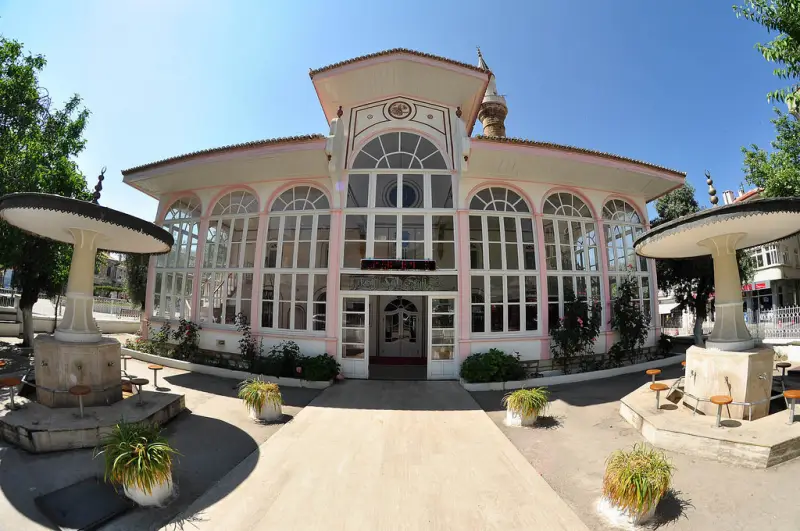
Kurşunlu Mosque (Kurşunlu Cami) is an Ottoman mosque located in the Menteşe Balıbey District. It was built in 1493 by Es seyit Şücaaddin. The narthex was later built by Şerif Efendi in 1900. Its minaret was built by Hacı İsmail in the same years. The mosque used to have a madrasah with thirty rooms in the past. it differentiates it from other mosques in Muğla. The most important feature of the mosque is its large lead-covered dome. The hand-carved decorations inside were made with madder paint brought from Rhodes. The main smooth cut stone walls bear the features of Seljuk Architecture.
Şeyh Mosque

It was built by Sheikh Bedrettin in 1565. The mosque has been restored several times in the last five century and the minaret was built in the early 19th century. The Şeyh Mosque (Şeyh Cami) is one of the oldest mosques in Muğla It is an important construction in history. Evliya Çelebi visited the mosque in 1671 and noted in his journals that the construction was an important place.
Yelli Mosque

This mosque takes place in the east of the city walls in the area called Kepez. The narthex of the mosque with a central dome is covered with two cross vaults. The dome sits on lozenge patterned pendentives. The narthex is accessed through the arch at the north corner of the west facade, surrounded by tiles. Additionally, a wide door from the east enables direct access to the mosque. The corner stones, door frame and arches are made of limestone. Ceramic cubes inside the wall at the level of the pendants inside the mosque provides acoustics. Most of the cubes are broken. It dates to the 14th century.
Firuz Bey Mosque
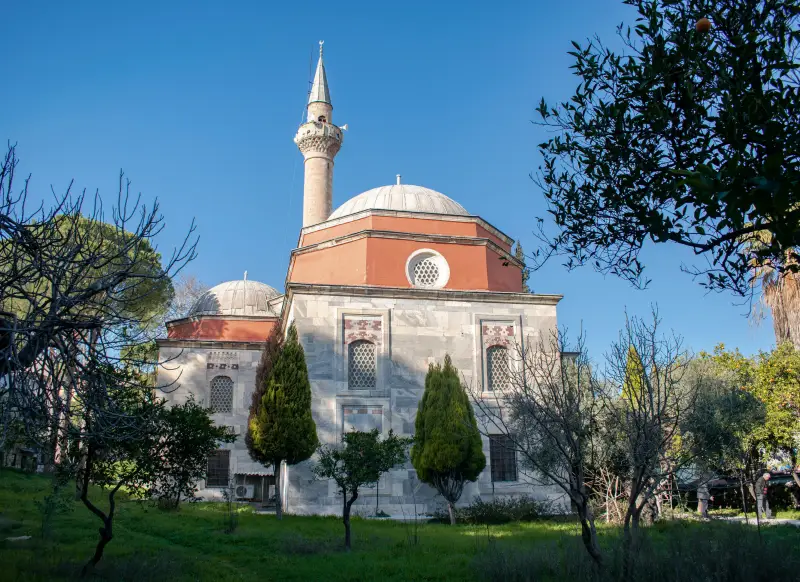
The building is located in the middle of a large courtyard in the Firuz Paşa District in the city centre. Firuz Bey Mosque was built in 1394. The south of the mosque between Hisarbaşı and Yeldeğirmeni is in the center of an area surrounded by madrasah rooms. The building is called “Kurşunlu” mosque owing to its lead-covered dome. It is called also “Gök” mosque because of the colour of the marble used in the main walls. There are three entrances to the courtyard from three directions: south, north and east. The building, which has characteristics of antique Ottoman architecture, has an inverted “T” plan.
Yediler Monastery
It is located in Gölyaka Village (Gölyaka Köyü) in the borders of Bafa District in Milas,Muğla.

It is the largest monastery in the region. The monastery consists of a large courtyard in the east and a small one in the west surrounded by rocks. To the north of the small courtyard, there is an upper castle surrounded by walls. There is also a shelter castle on a single rock to the south, fortified with loopholes.
It was probably a religion centre in the southwest. There are two chapels and an apse formed by a wall on the inside, used as a chapel. The entrance to the underground front room of the chapel is serviced by a staircase in front of the west wall of the church.
There are wall paints with scenes of Jesus’ life, actions and death, the resurrection of Lazarus, the crucifixion of the Prophet Jesus, the tomb and the Anastasis (resurrection) scene, and other important events in Christianity.
Clock Tower

In 1895, the first Mayor of Muğla, Hacı Kadızade Süleyman Efendi, and his wife Pembe Ana, wanted to replicate the tower they saw in Damascus. So, they had the present clock tower built by the famous Greek masters Filvarus (Mikhail Constantine’s son).
Myndos Ancient City
The city of Myndos is one of the cities mentioned by the ancient writers, what is now known as Gümüşlük. It was founded by the king Mausole of Caria. It is very easy to reach. There are Byzantine churches, city walls, the remains of the fortifications, and the ruins of the jetty and tower. Apart from them, there is nothing seen on the ground. However, if observed well, half-covered columns, mosaic traces, ceramic pieces can be seen almost everywhere under the ground. This city, which Alexander the Great had surrendered but failed to conquer, is a cute fishing village today.
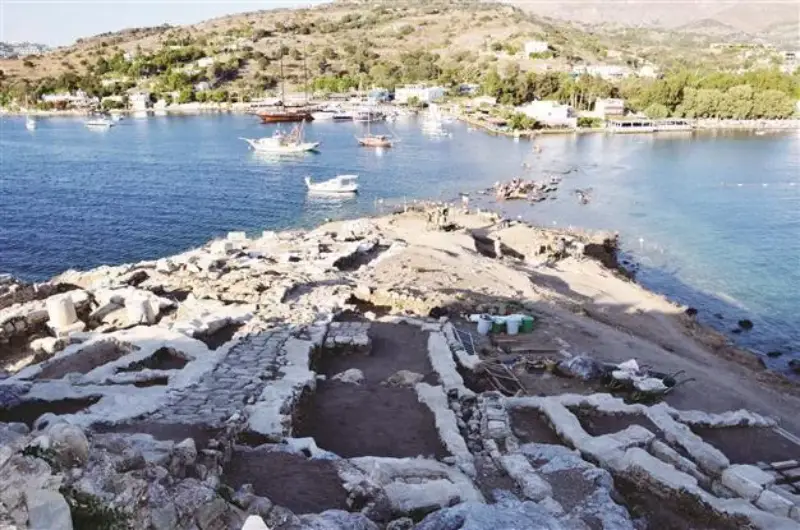
It is a place that produced wine in ancient times. With the thought of being good for the stomach, People drunk Myndos wine after blending it with sea water. This custom used to be seen elsewhere in ancient times. The town of Gümüşlük, today’s Myndos, is famous for its tangerine gardens. Even though not on a big scale, rug weaving is also a part of the culture. Koyunbaba resort near Gümüşlük was used as a quarry during Mausoleus era. It is one of the places worth seeing.
Bodrum Ancient Theatre
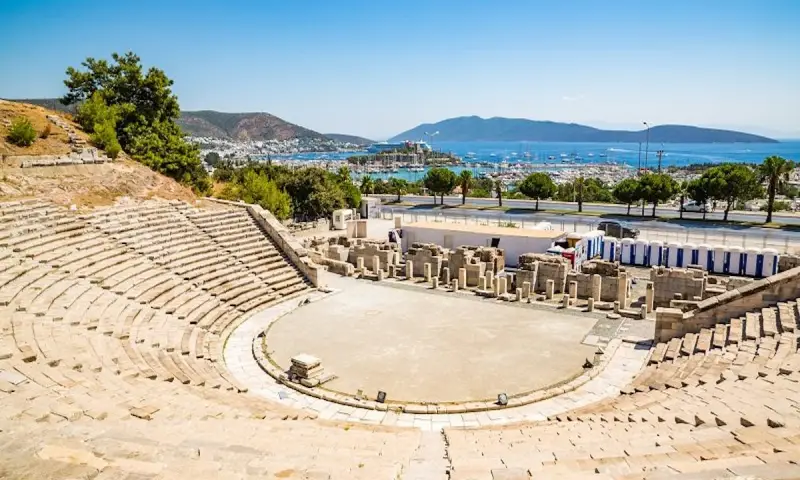
The structure is an astonishing building dating back to the 4th century BC. It is located in the north of Halicarnassus antique city on the southern slope of Göktepe. The theatre was used as a necropolis( a cemetery ). It has all the features of theatre prior to the Roman Imperial Period. The Antique Theatre is the only building to have survived from the Classical Age of Bodrum. Of all the interesting features of the theatre, here is the altar, where the sacrifices were offered to Dionysus before the games. There are holes between some of the seats. they may have used it as a canopy. With a distance of 40 cm between each seat, the theatre has a capacity of 13,000 people. We recommend you to visit there during summer and during your best moments!.
“>
Kadı Kalesi Church

The main construction of the Kadı Castle Church (Kadı Kalesi Kilisesi) is quite good. However, it is still empty and not used. Most of the structures attract tourist as an example of the Hellenistic era. Back in those days, Bodrum judges gathered in these buildings so as to make vital decisions. Kadı Castle Church was the most critical place in which local decisions were made during the Ottoman Empire (Osmanlı İmparatorluğu). It was used as the supply port of the navy of Ottoman. It later played an crucial role in border trade with Kos and Kalymnos islands.
Bodrum Castle
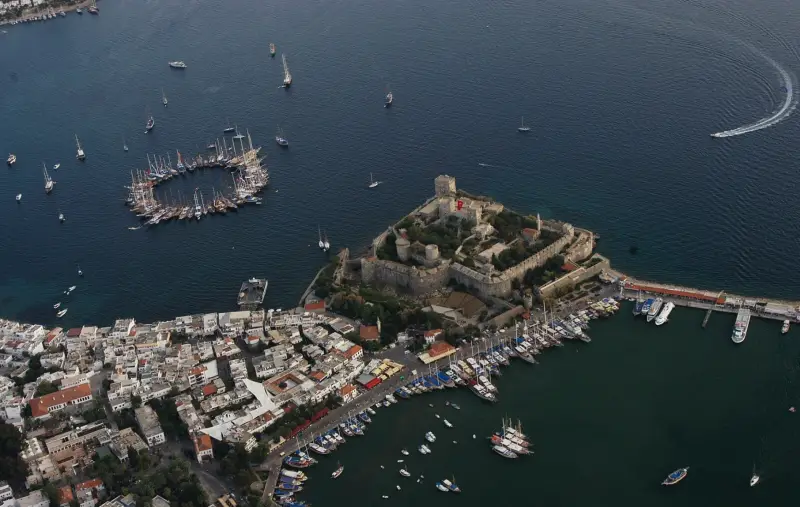
The Bodrum Castle (Bodrum Kalesi) was built on the island known as Zephyirion in ancient times. Nevertheless, It is a peninsula now. It was built in 1406 by the knights of St. Jean headquarter of whom was Rhodes. Bodrum Castle preserves the original plan and character of the Knights Period and reflects Gothic architectural. The Castle is the one and only well-preserved example of the St. John knights. It is also one of the best preserved medieval monuments in the world. It stands as a monolithic heritage. In the construction of the castle, the stones left after the destruction of Mausoleion ( one of the Seven Wonders of the World ) were used. It was only after the St Jean knights left Bodrum in 1523 that The Ottomans used it as a prison until the 19th century. It was damage because of the British and French bombardment during World War I.
Bodrum Underwater Archaeology Museum
Today, the Bodrum Castle harbors the Bodrum Underwater Archaeology Museum (Bodrum Sualtı Arkeoloji Müzesi). The Bodrum Underwater Archaeology Museum is one of the most important the world’s few and Türkiye’s only underwater museums. The museum was awarded “Special Praise” by the European Museum of the Year competition in 1995.
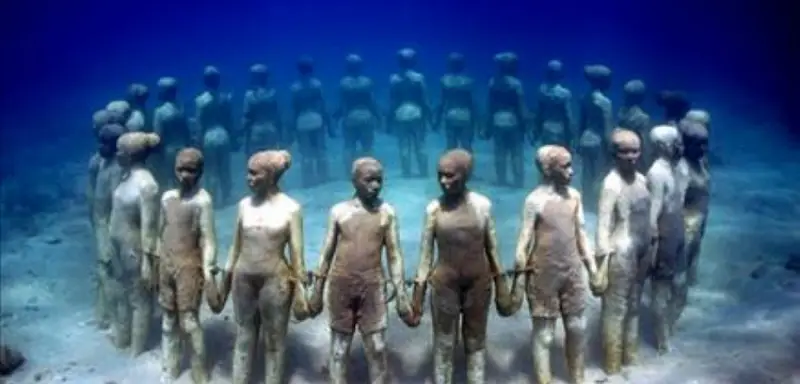
There are 14 exhibition halls and it has the richest Eastern Mediterranean Amphora collection in the world. The shipwrecks of Yassıada, Şeytan Deresi and Serçe Limanı are also exhibited in it. 3 tons of broken and unbroken glass was removed from the ship that sank in 1025, which is the oldest sunken ship wreck in the world. Additionally, the world’s largest Islamic Glass Collection is exhibited here.

The Bodrum Archaeology Museum consists of the Karyalı Princess Hall, English Tower, East Roman Wreck, Turkish Bath Exhibition, Glass Shipwreck Hall, German Tower, Coin and Jewellery Hall, Glass Hall, Hidden Museum Snake Tower, Uluburun Shipwreck, Dungeon, Commander’s Tower and Tektaş Glass Wreck sections.
The largest Amphorae Collection is also in the Bodrum Underwater Archaeology Museum. Next to the cross vault, there is the Balta Tower with the “Queen Island” hall.
Mausoleum Memorial Museum
Considered as one of the Seven Wonders of the Ancient World, the Memorial of the Mausoleum at Halicarnassus (a tomb built for Mausolus) is one of the most important historical places you should visit in Bodrum. Mausolus, one of the Hekatomnos dynasties, who was assigned as a Satrap to the Caria Region by the Persians, started its construction while still alive (in 353 BCE) and continued to be built by his wife and sister Artemisia when he died. Mausolus, the most important ruler of the time, probably decided to make such an important structure in order to symbolize hiz immortality and greatness.
Synonymous with Bodrum’s history is the Turkish author of essays and novels, Cevat Şakir Kabaağaçlı, who is also known as the “The Fisherman of Halicarnassus. He wrote regarding the architecture of the Mausoleum: “Just think about it! Making something brand new by kicking all traditions… That drives you crazy! Whenever I think about this challenge, a tambourine and a drum roar inside me”

In the list of Seven Wonders of the World, Mausoleion’s height is 80 ion feet. This is approximately 50 meters, the height of a 20-storey apartment building.
Ancient writers state that the architect of the building was Pytheos, who was also the architect of the Priene Athena Temple. Vitrivius says that the most important sculptors of the period worked in this building in the 4th century BCE. Bryaxis among the Sculptors was in fact from Caria; and he was the one, who sculpted the statues of Mausolus and Artemisia standing on a 4-horse chariot on top of the Mausoleum. The monument survived for 1500 years, but collapsed during the earthquake in 1304. Today, the Mausoleum stays as one of the World’s Seven Wonders of the World. This place is among the top attractions in Mugla.
Stratoniceia Ruins

Stratoniceia ancient city was founded in the 3rd century BC. Syrian King Seleucus I. married to his wife Stratonice with his son Antiochus. Antiochus founded a city and named it after Stratonice, who was his stepmother and then his wife. According to the traveller and writer Strabon, the city was full with beautiful buildings. From the coins found during the excavations, the city started its independent coinage from Rhodes in 167 BC. It continued until the time of Gallienus (253-268 CE). The cemetery of the city is on the top of the mountain in the south. This hill is surrounded by a wall. To the north, on a terrace on the slope, just below the current highway, there are the remains of a small tomb built for the emperor. This place is among the top attractions in Mugla.
Ruins of Heracleia at Latmus
In ancient times, this region was known by the name Latmus because of the Mother Goddess Lada. The Hellenes changed the name Lada to Latmus. They named their city after it. The city remained under the rule of Pleistarchus from the Ptolemaic dynasty for ten years at the beginning of the 3rd century BC.
The city was named Pleistarcheia during that period, and later renamed by Lysimachus to Alexandreia on the coast of Latmus. However, these names were not permanent. It was mentioned in the Battle of Miletos-Magnesia in the 2nd century BC. Nonetheless, it is not certain exactly when the city was built. Its importance grew after being independent during the Roman period. In the 7th-9th centuries in which it became an episcopal centre, many churches and monasteries were built. Heracleia at Latmus experienced its peak in the Hellenistic period. The city walls were enlarged by Lysimachos in 287 BCE and its length reached 6.5 km.

Upon the abandonment of Heracleia, monasteries and churches were built in the first half of the CE 8th century. 170 of the rock paintings symbolizing the transition from Paleotic to Neolithic time have been found in the excavations. This place is among the top attractions in Mugla.
Kaunos Rock-Cut Tombs
Kaunos is one of the most interesting places in Türkiye with its rock tombs. It was once a commercially important port. However, it lost its port feature when the sea was filled with alluviums over time. The acropolis forming the heart of the city was built on a 152-meter-high hill. The northern part of the city walls dates back to Middle Ages. The long wall stretches from the north side of the harbour to the steep cliffs beyond Dalyan Village. The northern part of the wall was built in the period of Mausolus. He is the famous Satrap (governor) of the Caria region where Kaunos is located. His tomb is considered one of the Seven Wonders of the World, and is located in Bodrum (Halicarnassos).
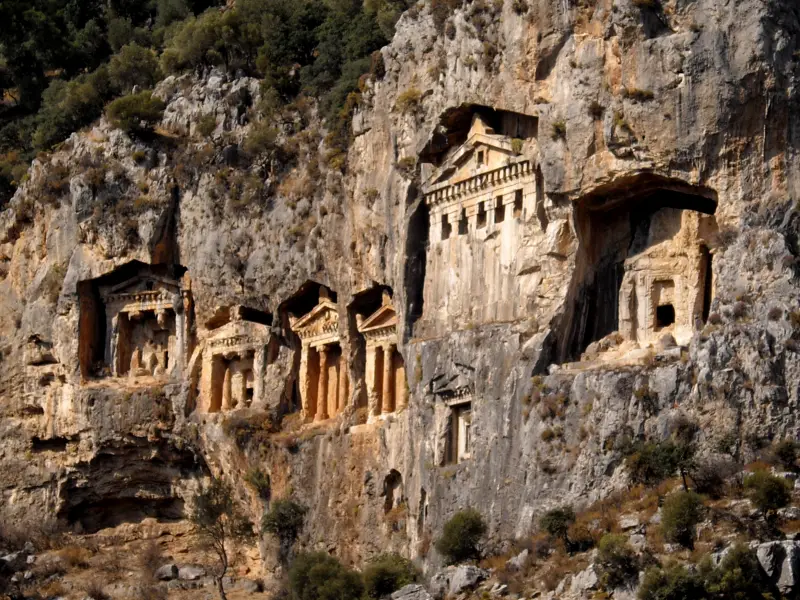
The walls in the northwest direction trace back to the Hellenistic Period (323 BC-30 BC). The walls extending towards the harbour dates back to the Archaic Period (750-475 BC). At the edge of the acropolis, there is the theatre of the ancient city. One of the buildings remaining in the western direction of the theatre belongs to the basilica type church. The others in the city are the remnants of the Roman bath and temple. The rock tombs seen from Dalyan are dated to the 4th century BC. They were later also used in the Roman period. The cavities carved into the rocks are places where giant fires were lit. They were used as lanterns to ships approaching the harbour to carry cargo to Kaunos. This place is among the top attractions in Mugla.
Knidos Ancient City
Knidos known as the Rhodes Regional Unit is one of the most important Western Anatolian coastal cities. It is located on Tekir Cape at the far end of the Datça Peninsula. the Aegean and the Mediterranean Seas meet around Datça. Knidos used to have a developed trade thanks to the wine export. The city was surrounded by walls reinforced with round and angular towers. She had two harbours, a military and a commercial one. Important buildings and areas in the archaeological site are the Doric Temple, the Temple of Apollo, The Round Temple, the Altar, the Assembly Building, the Corinthian Temple, the sundial showing the season and the time, the Theatre, the Temple of Dionysus and the Slope Houses, the Odeon, the Sacred Place of Demeter, the Necropolis and the Krio Peninsula.

British archaeologist Charles Newton note down on his diary during the excavations in Knidos in 1858: “…a monumental tomb that Halicarnassos would be proud of: His mausoleum, a monumental statue of Rhodes cast from bronze: If there is Helios, the small town of Knidos, also likewise there is a statue of Aphrodite that he can be proud of; it is the statue that Nikomedes, King of Bithynia (north of Aegean region), reveals all the income of the city in return; All the debts of Knidos have been erased, but in vain…”Although the naked Aphrodite sculpture made by the sculptor Praxiteles for Knidos has not been found and only its pedestal can be seen today. This place is among the top attractions in Mugla.
Tlos Ancient City
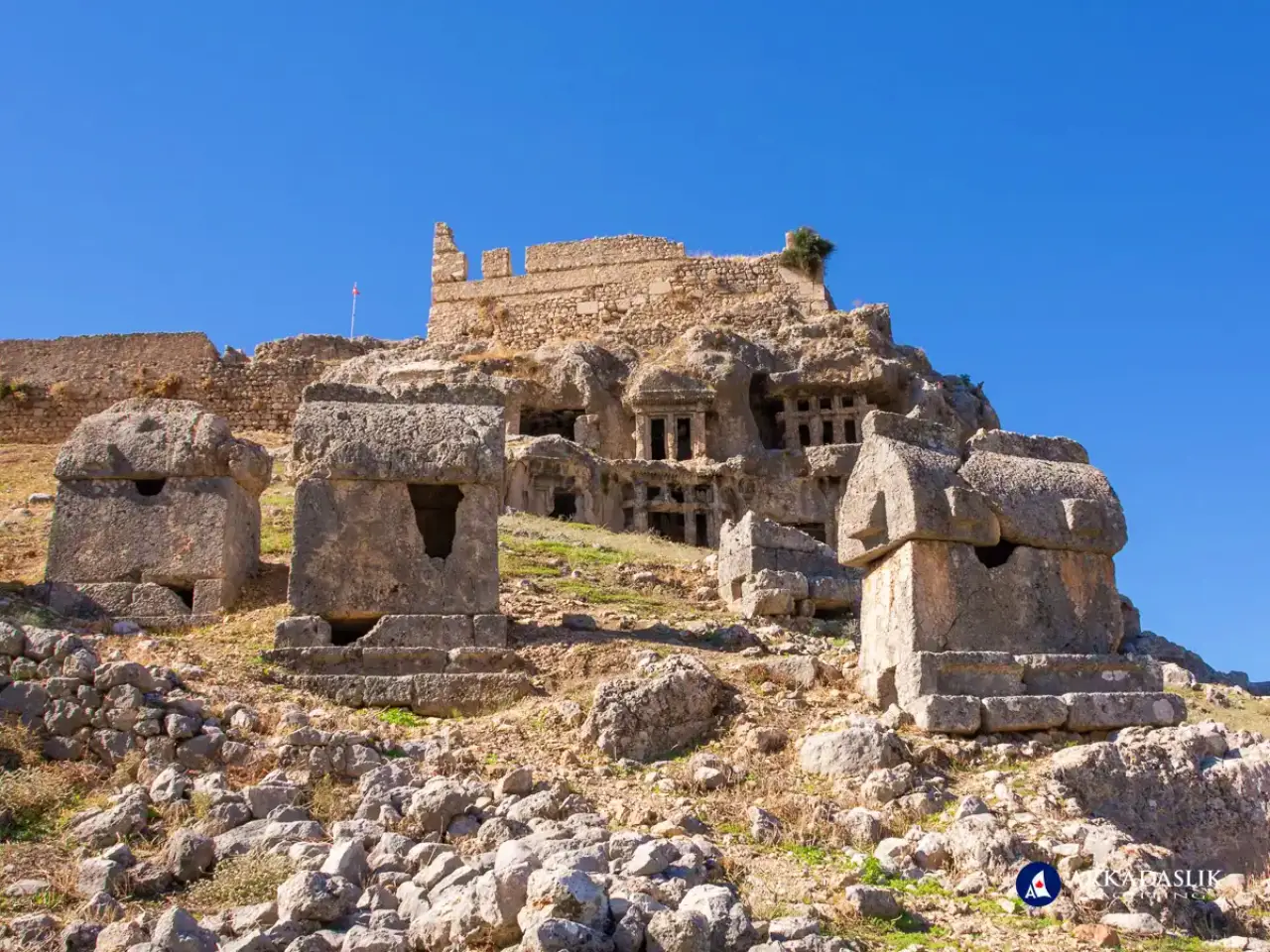
In the 2nd century BC, Tilos entered the Lycian Union and Continued its existence in the Byzantine period. Tlos was one of the rare ruins having survived until the 9th century. The transportation was provided through the Kemer district on the Fethiye-Korkuteli road, 13 km after the Yaka village Castle. The history of members of Lycia dates back to the 5th century BC. No older documents have been recovered. Therefore, we cannot know the exact establishment of these cities, but life in Lycia starts in the 2nd century BC. An axe found by chance in Tlos is also evidence supporting this thesis. It is known that Tlos existed in the 2nd century under the name Talaw.
This place is among the top attractions in Mugla. We recommend you to visit there during summer.
Hekatomnos Memorial Tomb
The Hekatomnos Mausoleum and Sanctuary (Hekatomnos Anıt Mezarı ve Kutsal Alanı) is located in the Milas district of Muğla. It is one of the most important cities of the Caria Region in southwest Anatolia. The Memorial Tomb and Sanctuary consists of the Temenos Wall, the Honour Column of Menandros, Podium and Tomb (Carrier Room, Tomb Room, Sarcophagus and Dromos). The Monuments has a unique value from various aspects. The mausoleum is regarded as one of the Seven Wonders of the Ancient World. We can date it back to an earlier period than the Mausoleum of Halicarnassus.
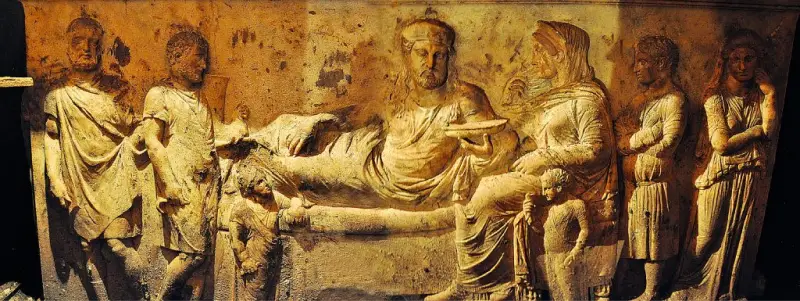
It is the monument of the father of Mausoleus also having the same dimensions and is the only one in these dimensions to have survived to our days. The tomb is the most important grave monument of the ancient world and the representative of the cult of the dead. It is at a high level in terms of both architectural design and other important branches of art. Especially the “Sarcophagus with Frescoes” is the only example in Classical and Hellenistic Anatolia. its size, quality and the important personality of its owner make it unique. This place is among the top attractions in Mugla.
Xanthos-Letoon Ancient Cities (UNESCO Heritage List)
Nearly 50 km away from Fethiye, Xanthos is located within the borders of Antalya. The city was the largest administrative centre of Lycia in ancient times. People of this city were independent until it came under the rule of the Persians in 545 BC. It was completely burned down to its ashes approximately a century later. the city was rebuilt upon the fire. It was the capital of the Lycian Union in the 2nd century BC. The Romans took the city under control. Later, Byzantine ruled the city until the Arab raids in the 7th century. It features the effects of Lycian traditions, and the Hellenistic and Roman periods, and which has traces of every civilization having inhabited it. The city was included in the UNESCO World Heritage List in 1988.

Letoon is 4 km away from Xanthos and located in the border of Muğla. It was the religious centre of Lycia in ancient times. This sacred contains a monastery ruins, a fountain, a Roman theatre, along with the temples of Leto, Apollo and Artemis. The largest temple dedicated to Leto, the mother of Artemis and Apollo, is the Leto Temple.
The city takes place in the west. It was built in the type of a Peripteros. The Apollo temple was built in the Doric style to the east. It is less preserved than the Leto temple and is 27.90 by 15.07 m and with smaller dimensions. Located in the middle of both temples and being the smallest temple, the temple of Artemis is 18.20 by 8.70 m in size. Letoon is included in the UNESCO World Heritage List (UNESCO Dünya Mirasları Listesi) along with Xanthos. This place is among the top attractions in Mugla. You should visit them during your stay.
Sedir Island
The altitude of the Sedir Island (Sedir Adası) ruin is nearly between 0 meters and 15 meters. Transportation to the area is served by daily excursion boats from Ula, Akyaka or by boats located in Çamlı Village of Marmaris Turkey districts of Muğla.
The island, formerly called Kedreai, is a settlement in the east of the Bay of Keramos. The island, called “Şehiroğlu” in the Ottoman Period, is now called “Sedir”. The name also comes from the cedar tree but unfortunately there is no cedar tree on it today.
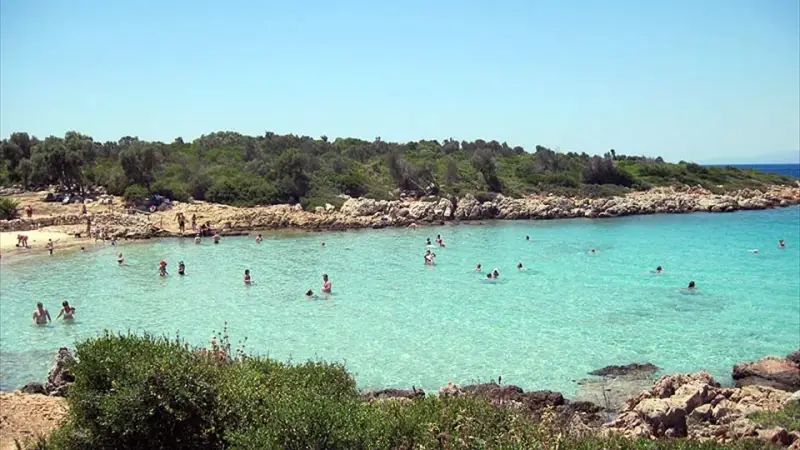
Having a coastline of approximately 800 m, The island consists of three islands with Orata and Küçük Ada. The settlement on Sedir Island was formed on the eastern side of the isthmos (isthmus) dividing the island into two. The theatre,residence, harbor, other important civil and religious buildings of the city are in this area surrounded by walls. Necropolis, a portion of the ports and other civil structures are located in the mainland on the eastern side. You should visit it during your stay.

In antique times, lands including Sedir Island were considered to belong to Rhodos. Bozburun Peninsula was the part of the Rhodos Peraia, where Rhodos influence was most intense throughout the ancient times. In the city, there is a theatre with a capacity of 2500 people, the Apollon Sanctuary, the Great Basilica, the Kıstak Church and the Agora. This place is among the top attractions in Mugla. You should visit them during your stay.
Idyma
The ancient city of Idyma has a history of about 2,500 years. It is within the borders of the Akyaka town. Today, the ruins of the city of Idyma extend from Gökova village to the edge of Kıran Mountain (Kıran Dağı). On the hill of Gökova, ruins of the acropolis of the city dated to the 4th and 3rd centuries BC are worth to see. On the east side of the same hill, there is a necropolis (cemetery) having witnessed pain and sorrow.
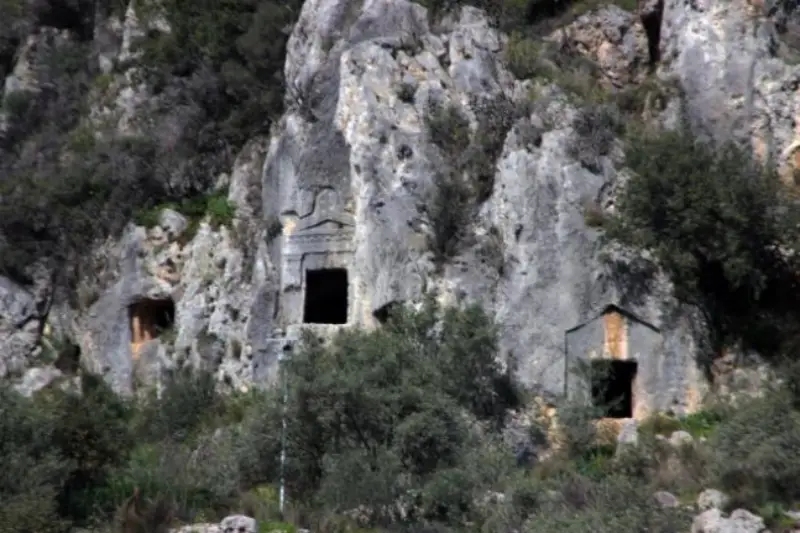
The tombs built by carving the rocks along the hill were created like a house to continue their lives. It points out that the citizens used to believe the life after death. Some of the rock tombs were built in a richer style than other rock tombs. This shows us the socio-economic differences in their period. The best-preserved example of these rock tombs is the monumental rock tomb in the area called İnişdibi. It is located between Akyaka–Gökova village. On the same road, the Byzantine castle stands on the low hill near Azmak. This place is among the top attractions in Mugla. You should visit them during your stay.
Aminthas Rock Tomb
There are many tombs carved on a steep slope in Fethiye. 3 of them are temple type and others reflect examples of civil architecture. Furthermore, This tomb is one of the three temple types and known as the “King’s Tomb” among the locals. It has remained relatively unchanged in comparison with the others. It was named as Aminthas Tomb (Aminthas Mezarı) due to the inscription “Aminthas son of Hermapias” on the central part of the ante walls. The city is dated to the 4th century BCE. This Ionic Regular in antis (temple type with two columns between the antes) is the projected form of the front facade of a temple on the rock. The other tombs are the symbol of the city and on the same slope to the east. They are the best examples giving information about the metal and woodworking of the Lycian Region.

There is a depiction of a door divided into four main panels in the section. It opens to the burial chamber. There is a smooth and rough ceiling and three klines In it. Telmessos Ancient City (Telmessos Antik Kenti) and tombs must have been seen by many in the 18th and 19th centuries. This place is among the top attractions in Mugla. You should visit it during your stay.
Kayaköy (Karmilissos)
Kayaköy is a village of Fethiye. It was known as Karmilissos in ancient time. The village dates back to 3rd century BC according to philological data. However, we haven’t been able to discover any findings dating back to older than 4th century BC. All of the building groups on the hillside of the town were built by Greeks. They settled there in the second half of the 19th century. In the first quarter of the 20th century, Ottoman Empire granted rights to minorities so that they could settle there. The village was abandoned owing to the Population Exchange between Greece and Türkiye. As a result, the wooden doors, windows and exterior of the houses decayed due to lack of maintenance.
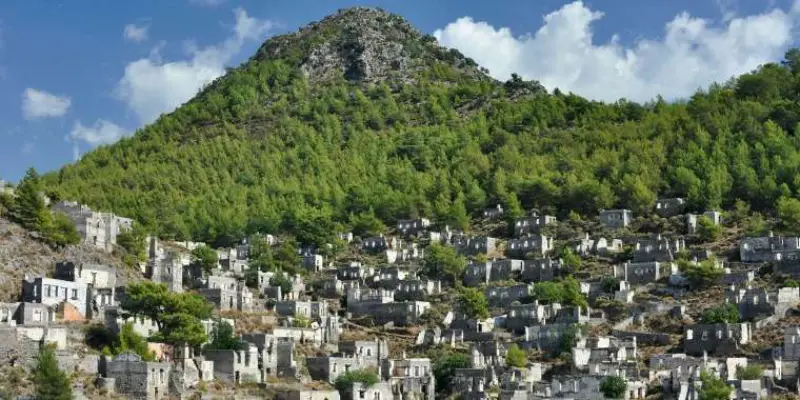

The village appears like a ghost city. Before abandoned, the 350-400 houses were built in a way that they wouldn’t obstruct each other’s view and light. The two-story buildings were not bigger than 50 sqm. The ground floors generally served as warehouse. Each house had an underground cistern, which the rain water rom the roof accumulated in. Besides the residences, there are many chapels among the houses, two large churches, a school building, and a customs building.
Iztuzu Beach – Loggerhead Sea Turtle (Caretta Caretta)
İztuzu Beach (İztuzu Plajı) is one of the last beaches to harbor loggerhead sea turtles. Furthermore, It is the second beach in the world to preserve its natural state. Known as caretta carettas, The adorable inhabitants of İztuzu Beach are 1-1.5 meters tall and 150 kilos. These cute animals go to the beach by using their hind legs. They then dig various holes and lay their eggs in the most appropriate way and return to the sea.
When their time comes, the hatchlings instinctively take the moonlight compass and head towards the sea. This job is not that easy. It takes a long time to reach the sea with the tiny steps of the baby carettas. They must go all the way until the sun rises and it starts to get warmer. Those who fail to do so and surpass the obstacles will be prey to the heat or birds. Of course, when they reach the sea, the danger does not end. Till they reach a certain size, they can not avoid becoming fish food. The few carettas that are able to grow and reach a giant size return to this beach they were born on. When they follow their instincts and lay their eggs, the loop will start once again.

When the hatching time comes, it is banned to use a light source or make fire on this beach. This is because the little ones mistake the light source for the moonlight. As I have noted, Eggs are taken under protection and no permanent facility is allowed on the beach. During hatching, environmentalists from all over the world camp on the beach. They sometimes support the march of the turtles. This beach is among the top attractions in Mugla. You should visit the beach during your stay.
Walking the ancient roads
Muğla has a great potential to provide the travelers with many alternative tourism types as well as the sea-sand-suna. The Lycian Way (Likya Yolu), the Carian Way (Karia Yolu) and the Kanuni Trail (Kanuni Yolu) are trekking routes. They are of great importance for trekking, which is an alternative tourism type. We recommend you to visit there during summer.
The Lycian Way, one of the oldest known roads with a length of 540 km. It connects 19 ancient cities through its path. As a result, It is regarded as one of the 10 best long-distance walking routes in the world.
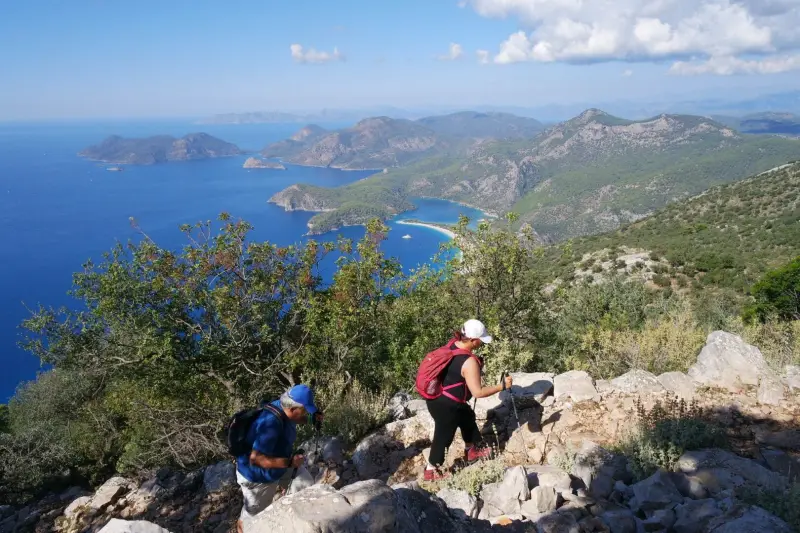
The Lycian Way has a history of thousands of years. The route is still active for nomads, starting from Fethiye to Antalya. The Lycian road stretches between the coast and mountains. It generally consists of Roman roads, old paths and mule roads. Along the course, there are beauties and creation of mother nature such as Kabak Bay (Kabak Koyu), Cennet Bay (Cennet Koyu), Butterfly Valley (Vadisi), Patara, Kekova, Korsan Cove, Gelidonya Lighthouse, Adrasan, Çıralı; ancient cities such as Antiphellos, Sdyma, Letoon, Limyra, Simena, Xanthos, Patara, Apollonia, Chimera, Myra, Olympos as well as Phaselis. It is possible to swim in untouched bays and stay in settlements, accommodation facilities or tents on the road. This place is among the top attractions in Mugla. You should visit them during your stay. We recommend you to visit there during summer.

